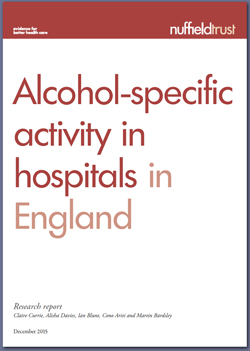Despite it being illegal to serve an intoxicated person with alcohol, pubs and clubs in the UK seem happy to sell as much alcohol as they can to their customers, irrespective of this law.
Whilst individuals are blamed for the state of our town and city's streets virtually every Friday and Saturday nights, and the alcohol industry continues to maximise profits at the cost of individual and society's health; the damning facts with regard to the extent of the problem that our alcohol obsessed society, continues to be ignored by successive UK governments.
A new report from the charity, The Nuffield Trust, brings into perspective the reality of hazardous levels of alcohol consumption that society, Governments and parents seem oblivious to; and unwilling to address.
Many will comment that Thatcher's abolition of alcohol sale controls allowing petrol stations, supermarkets and on-line shops to supply alcohol at all times of the day and night; is the main reason why alcohol is so cheap to buy and why we know face epidemic levels of alcohol related illness and deaths.
The Nuffield Trust website highlights the report and have issued the following press release:
 Alcohol-related harm is placing increasing demands on the NHS. At a time when unprecedented efficiencies need to be made by the NHS and local authorities, preventative action must be taken seriously.
Alcohol-related harm is placing increasing demands on the NHS. At a time when unprecedented efficiencies need to be made by the NHS and local authorities, preventative action must be taken seriously.
This analysis explores trends in alcohol-specific activity in hospitals in England. The analysis also explores the use of hospital services before and after a diagnosis of alcohol-related liver disease (ALRD) and highlights opportunities for preventative action to reduce future alcohol-related harm in England.
Summary
*Alcohol misuse costs the UK economy an estimated £7.3 billion per year. In England alone, estimates suggest that over 15,000 people die from alcohol-related illnesses each year.
*The costs to the NHS of alcohol-related harm arise from a number of areas. For example, up to 35% of all Accident & Emergency (A&E) attendance and ambulance costs may be alcohol related.
*In 2013/14, over a million hospital admissions were as a consequence of an alcohol-related diagnosis, and this figure is increasing. The effect is not only evident in hospital care, with 22 to 35% of GP visits estimated to be related to alcohol. The true impact of alcohol on the health service is likely to be even higher than this.
This report analyses both trends in A&E visits and trends in hospital admissions that are attributable to alcohol-specific activities. Based on the findings it explores opportunities for preventative action.
Key Findings
*There is an increasing alcohol-related burden on England’s hospitals. For example, from 2008/09 to 2013/14, A&E attendance rates likely due to alcohol poisoning doubled, from 72.7 per 100,000 population to 148.8 per 100,000 population (a 104.6% increase). Additionally, from 2005/06 to 2013/14, inpatient admissions specific to alcohol increased by 63.6%.
*There were higher admission rates among older, poorer men. In 2013/14, the highest rates of emergency admission were found in 45–64-year-old men (1,126.0 per 100,000 population). And more generally, A&E attendance rates likely due to alcohol poisoning and hospital emergency admissions specific to alcohol were three to four times higher in the poorest fifth of the population.
*There is a need to take better advantage of opportunities to intervene. 90% of those who attended A&E due to likely alcohol poisoning and 72% of those who had an alcohol-specific emergency admission only attended hospital (in any setting) once in 2013/14.
*On the other hand, about 75% of those diagnosed with alcohol-related liver disease (ARLD) during 2009/10 had contact with hospital services in the year before diagnosis. This presents an opportunity to identify issues of alcohol dependency, and to provide specialist advice and onward referral, which may prevent progression to ARLD.
Greater preventative measures should be considered.
*Approximately 73% of hospitals (deemed to be of an appropriate size) have some form of alcohol service.
However, recent cuts, both to public health and local government budgets, raise concerns over the sustainability of funding for local alcohol services. Population-based approaches to reducing alcohol-related harms – such as increased taxation, minimum unit pricing, restricting availability and limiting marketing and advertising – should also be considered.
Source: The Nuffield Trust
The full report can be downloaded from the E-Library Database or by clicking on the pic above.


